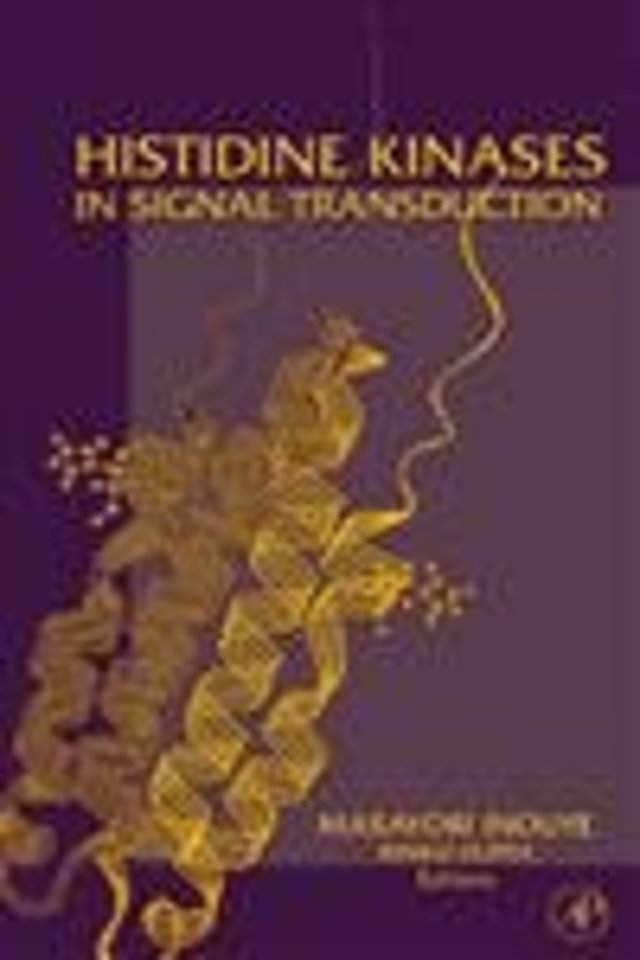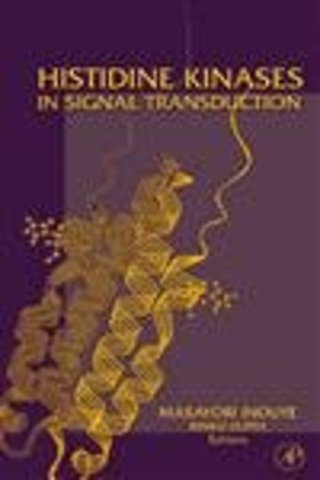<br>Preface</br><br>Contributors</br><br>1 Histidine Kinases: Introductory Remarks</br><br> Introduction</br><br> Basic Structure of Histidine Kinases (HKs)</br><br> Uniqueness of HKs</br><br> Difference between HKs and Ser/Thr/Tyr Kinases</br><br> Signal Transduction Mechanism</br><br> Regulation of Kinase and Phosphatase Activities: Switch Model and Rheostat Model</br><br> Concluding Remarks</br><br> References</br><br>2 The Histidine Kinase Family: Structures of Essential Building Blocks</br><br> Introduction</br><br> Kinase/Phosphatase Core Domain</br><br> Phosphotransfer Domain</br><br> Considerations on Domain Interactions</br><br> Concluding Remarks</br><br> References</br><br>3 Regulation of Porins in Escherichia coli by the Osmosensing Histidine Kinase~hosphatase EnvZ</br><br> Introduction</br><br> Domain A Is the Catalytic Domain</br><br> Domain B Is the Catalysis-Assisting and ATP-Binding Domain</br><br> Monomeric Histidine Kinase: Topological Arrangement between Domain A and Domain B</br><br> Role of DNA in EnvZ Function</br><br> Stoichiometric Complex Formation between EnvZ and OmpR</br><br> Regulation of Kinase and Phosphatase Activities: Switch Model versus Rheostat Model</br><br> Mechanism of Osmoregulation</br><br> Concluding Remarks</br><br> References</br><br>4 Structure and Function of CheA, the Histidine Kinase Central to Bacterial Chemotaxis</br><br> Introduction</br><br> Modular Structure of CheA</br><br> A Superfamily of Histidine Kinases and ATPases</br><br> Nucleotide Binding by CheA P4 and the GHL ATPases</br><br> ATP Hydrolysis and Conformation of P4</br><br> HPt Domain P1 and Phosphoryl Transfer</br><br> P2 Domain and Response Regulator Coupling</br><br> A Separate Dimerization Domain</br><br> Receptor Coupling by the P5 Regulatory Domain</br><br> Is Flexibility between Domains Important for Signaling?</br><br> Controlling Protein-Protein Interactions with ATP</br><br> Prospects for the Design of Antibiotics Directed at CheA</br><br> What Is Next?</br><br> References</br><br>5 Transmembrane Signaling and the Regulation of Histidine Kinase Activity</br><br> Introduction</br><br> Membrane Receptor Kinases</br><br> Type I Histidine Kinase Receptors</br><br> Receptors with Several Membrane-Spanning Segments</br><br> Transmembrane Signaling in Bacterial Chemotaxis</br><br> Conclusions</br><br> References</br><br>6 Structure-Function Relationships: Chemotaxis and Ethylene Receptors</br><br> Introduction</br><br> Chemotaxis and Chemoreceptors</br><br> The Ethylene Receptor</br><br> Chemoreceptors and Membrane-Bound Histidine Proteins Kinases</br><br> References</br><br>7 New Insights into the Mechanism of the Kinase and Phosphatase Activities of Escherichia coli NRH (NtrB) and Their Regulation by the PII Protein</br><br> Introduction</br><br> Mechanism of NRII Autophosphorylation and Regulation of This Activity by PII</br><br> Regulation of the Transphosphorylation Activity of NRII by PII</br><br> Evidence for Conformational Alteration of NRII by PII Binding</br><br> Mapping the Interaction of PII with NRII</br><br> Mapping the Activities of NRII</br><br> Explaining the Activities of Mutant Forms of NRII</br><br> References</br><br>8 Role of the Histidine-Containing Phosphotransfer Domain (HPt) in the Muhistep Phosphorelay through the Anaerobic Hybrid Sensor, ArcB</br><br> Introduction</br><br> HPt Domain</br><br> Structure and Function of Common HPt Domains</br><br> Multistep ArcB→ArcA Phosphorelay System in Escherichia coli Anaerobiosis</br><br> Advantage of Multistep Phosphorelay</br><br> Multisignaling Circuitry of the ArcB→ArcA Phosphorelay</br><br> Phospho-HPt Phosphatase Is Involved in the ArcB→ArcA Signaling Circuitry</br><br> Physiological Role of SixA-Phosphatase in Response to Anaerobic Respiratory Conditions</br><br> Cross-Phosphorelay Occurs on OmpR through EnvZ Osmosensor and ArcB Anaerosensor</br><br> Atypical HPt Factor Is Involved in the Multistep RcsC→YojN→RcsB Phosphorelay</br><br> HPt Domains in Higher Plants</br><br> Concluding Remarks</br><br> References </br><br>9 Genome-Wide Analysis of Escherichia coli Histidine Kinases</br><br> Introduction</br><br> Histidine Kinase Genes in the E. coli Genome</br><br> Versatility of E. coli Histidine Kinases</br><br> Deletion Analysis of Every Histidine Kinase Gene in the E. coli Genome</br><br> DNA Microarray Analysis of Histidine Kinases for Gene Regulations</br><br> References</br><br>10 Signal Transmission and Specificity in the Sporulation Phosphorelay of Bacillus subtilis</br><br> Introduction</br><br> Structural Characterization of Phosphorelay Components</br><br> Interactions of the Response Regulator with the Phosphotransferase Domain</br><br> Conclusion</br><br> References</br><br>11 Histidine Kinases: Extended Relationship with GHL ATPases</br><br> Introduction</br><br> Diverse Functions Supported by a Conserved ATP-Binding Site</br><br> Features of the ATP-Binding Site</br><br> Mechanistic Implications</br><br> Closing Remarks</br><br> References</br><br>12 Response Regulator Proteins and Their Interactions with Histidine Protein Kinases</br><br> Introduction</br><br> Regulatory Domains</br><br> Effector Domains</br><br> Regulation of Response Regulatory Phosphorylation</br><br> Interactions of Response Regulators with Histidine Kinases and Histidine-Containing Phosphotransfer Domains</br><br> Perspectives</br><br> References</br><br>13 Cyanophytochromes, Bacteriophytochromes, and Plant Phytochromes: Light-Regulated Kinases Related to Bacterial Two-Component Regulators</br><br> Introduction to Phytochromes (Phys)</br><br> Phys as Proteins Kinases?</br><br> Discovery of Cyanophytochromes (CphPs) and Bacteriophytochromes (BphPs)</br><br> Photochemical Properties of CphPs and BphPs</br><br> Histidine Kinase Domains and Kinase Activity for CphPs and BphPs</br><br> Biological Functions of Prokaryotic Phys</br><br> Do Higher Plant Phys Function as Two-Component Histidine Kinases?</br><br> Functions of the Kinase Activity of Phys</br><br> BphP, CphP, and Phy Evolution</br><br> Conclusions</br><br> References</br><br>14 Histidine Kinases in the Cyanobacterial Circadian System</br><br> Introduction</br><br> Cyanobacterial Circadian Rhythms</br><br> Molecular Genetics of Cyanobacterial Circadian System: Kai Genes</br><br> SasA, a KaiC-Binding Histidine Kinase as a Circadian Amplifier</br><br> CikA, a Bacteriophytochrome Family Histidine Kinase as a Circadian Photic Input Factor</br><br> Perspectives: Toward Further Understanding of His-to-Asp Signaling</br><br> Pathways in the Circadian Network in Cyanobacteria</br><br> References</br><br>15 Two-Component Control of Quorum Sensing in Gram-Negative Bacteria</br><br> Introduction</br><br> Quorum Sensing in Vibrio harveyi</br><br> Quorum Sensing in Myxococcus xanthus</br><br> Conclusions</br><br> References</br><br>16 Intercellular Communication in Gram-Positive Bacteria Depends on Peptide Pheromones and Their Histidine Kinase Receptors</br><br> Introduction</br><br> Intercellular Communication by Unmodified Peptides</br><br> Intercellular Communication by Modified Peptides</br><br> Bacteria Speak Different Languages</br><br> Peptide Pheromones Depend on Histidine Kinase Receptors</br><br> The HPK10 Subfamily of Histidine Kinases</br><br> References</br><br>17 Initiation of Bacterial Killing by Two-Component Sensing of a "Death Peptide": Development of Antibiotic Tolerance in Streptococcus pneumoniae</br><br> Introduction</br><br> Cell Death and Signal Transduction</br><br> Summary and Perspectives</br><br> References</br><br>18 Role of Multiple Sensor Kinases in Cell Cycle Progression and Differentiation in Caulobacter crescentus</br><br> Introduction</br><br> Temporal and Spatial Control of Cell Cycle Events</br><br> Levels of Developmental Regulation</br><br> Control of Differentiation by Cell Cycle Checkpoints</br><br> Two-Component Signal Transduction and Cell Cycle Regulation</br><br> Summary and Perspectives</br><br> References</br><br>19 The Slnl-Ypdl-Sskl Multistep Phosphorelay System That Regulates an Osmosensing MAP Kinase Cascade in Yeast</br><br> Introduction</br><br> The Common Downstream Pathway</br><br> The SLN 1 Branch</br><br> The SHO 1 Branch</br><br> Concluding Remarks</br><br> References</br><br>20 Histidine Kinases of Dictyostelium</br><br> Introduction </br><br> Eukaryotic Histidine Kinases</br><br> Dictyostelium Histidine Kinases</br><br> Phenotypic Analyses</br><br> Double Mutants</br><br> Structure and Function of DhkA</br><br> The Late Adenylyl Cyclase ACR</br><br> Summary and Perspectives</br><br> References</br><br>21 Ethylene Perception in Arabidopsis by the ETR1 Receptor Family: Evaluating a Possible Role for Two-Component Signaling in Plant Ethylene Responses</br><br> Introduction</br><br> ETR1 Family Gene Structure and Biochemistry</br><br> Ethylene Sensor Domain</br><br> GAF-like Domain</br><br> Histidine Kinase-Coupled Receptor</br><br> Receiver Domain</br><br> Kinase Activity in the Cytosolic Portion of ETR1</br><br> Mutational Analysis of the Ethylene Pathway</br><br> TwomComponent Signaling through MAPk Kinases in Saccharomyces cerevesiae and Arabidopsis</br><br> References</br><br>22 Pathogenicity and Histidine Kinases: Approaches Toward the Development of a New Generation of Antibiotics</br><br> Introduction</br><br> Are Histidine Kinases Good Antibacterial Targets?</br><br> Alternatives to High Throughput Screens: Possibilities for Structure-Based Screening for Identification Histidine of Kinase Inhibitors</br><br> References</br><br>23 Molecular Evolution of Histidine Kinases</br><br> Introduction</br><br> Domains of Histidine Kinases</br><br> Evolution of Histidine Kinases</br><br> Conclusion</br><br> References</br><br>Index</br>

